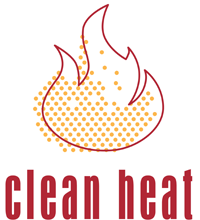Clean heat
About 65% of energy consumed in private households is used for heating. As a renewable fuel, wood can be a good alternative to heating with oil, gas and coal. But stoves and boilers have to become substantially cleaner.
It’s in your hands to reduce emissions from residential burning:
- Avoid emissions by reducing heat requirements.
- Shift to clean and sustainable alternatives.
- Improve: Buy only stoves and boilers with fewer emissions.

Avoid: The soundest measure is to minimize the heat consumption of houses by better insulation (e.g. new windows, facade insulation). Whether wood burning is a supplementary heat source (stove) or the primary heat source (boiler), the energy renovation of the home will effectively reduce the amount of wood burned and the related air pollution.
Shift: Renewable sources such as solar heat and geothermal or ambient heat, including efficient heat pumps, are recommended. Renewable or biomass-based district heating from combined heat and power plants can also be an eco-friendly solution. In urban areas, surplus heat from industry may be used for heat supply.
Improve: The health hazardous particle pollution from new wood stoves and boilers connected to a good chimney will under optimal conditions be lower than the that of older appliances. However, pollution from new stoves and boilers is still much higher than the pollution from other heat sources. Thus, effective emission reduction technology needs to become standard!
To push such low-emission technology, Clean Heat initiated a new eco-label for firewood stoves (available since January 2020). It is based on the Blue Angel scheme (Blauer Engel), the most well-known and trusted eco-label in Germany. The new eco-label addresses the key issues with stoves currently sold on the market through:
- A more realistic test procedure, including measurement of the number of particles emitted
- Very ambitious emission limit values that will make precipitators (filters) obligatory
- Effective technical provisions to reduce operating errors, such as an automatic combustion air control and a monitoring of the burning process (e.g. prompting the operator to refuel)
- Requirement that stove and precipitator need to be installed and operated together
The first stoves with the new eco-label are already on the market. This will help guide purchasing decisions of consumers, but the eco-label should also serve as a minimum standard for stoves operated in polluted areas and provides a blueprint for the revision of European standards.
With regard to current appliances available in the market, a rule of thumb is: The less influence of user behavior and of fluctuating fuel quality and the more automatization, the fewer emissions will be caused. With regard to logwood appliances, stoves automated combustion air control or two-stage combustion (gasification) emit less than standard appliances in the market. In addition, exhaust cleaning technology is very useful to reduce emissions (precipitator/particle separator, catalytic converter). Further development efforts are needed to improve these technologies.
Although automated boilers are usually more efficient and have lower emissions than stoves, they should also be equipped with additional exhaust cleaning in order to reduce fine and ultrafine particles.

New Blue Angel eco-label for firewood stoves
What else needs to be considered?
- Proper dimensioning: If a new stove is to be purchased, proper dimensioning and a smart integration in an overall heating concept is strongly required (e.g. buffer storage for excess heat).
- Optimal firing: In contrast to automated (pellet) appliances, emission from firewood stoves depend considerably on user behavior and the quality of the firewood used. Therefore, the optimal fuel, the right method to ignite and to pile the fire up as well as regular maintenance of a stove is a 'must'. Read more...


